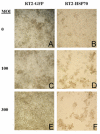Heat shock protein 72 expression allows permissive replication of oncolytic adenovirus dl1520 (ONYX-015) in rat glioblastoma cells
- PMID: 15762988
- PMCID: PMC555846
- DOI: 10.1186/1476-4598-4-12
Heat shock protein 72 expression allows permissive replication of oncolytic adenovirus dl1520 (ONYX-015) in rat glioblastoma cells
Abstract
In this study we have made novel observations with regards to potentiation of the tumoricidal activity of the oncolytic adenovirus, dl1520 (ONYX-015) in rat glioblastoma cell lines expressing heat shock protein 72 (HSP72) due to permissive virus replication. ONYX-015 is a conditionally replicating adenovirus that is deleted for the E1B 55 kDA gene product whose normal function is to interact with cell-cycle regulatory proteins to permit virus replication. However, many murine and rodent cell lines are not permissive for adenovirus replication. Previously, it has been reported that the heat shock response is necessary for adenovirus replication and that induction of heat shock proteins is mediated by E1 region gene products. Therefore, we hypothesized that HSP72 expression may allow for permissive replication of ONYX-015 in previously non-permissive cells. Rat glioma cell lines 9L and RT2 were transfected with a plasmids expressing HSP72 or GFP. After infection with ONYX-015, no tumoricidal activity is observed in GFP expressing cell lines despite adequate transduction. In contrast, HSP72 transfected cells show cytopathic effects by 72 hours and greater than 75% loss of viability by 96 hours. Burst assays show active virus replication in the HSP72 expressing cell lines. Therefore, 9L-HSP72 and RT2-HSP72 are ideal models to evaluate the efficacy of ONYX-015 in an immunocompetent rat model. Our study has implications for creating rodent tumor models for pre-clinical studies with E1 region deleted conditionally replicating adenovirus.
Figures





Similar articles
-
Heat shock phenocopies E1B-55K late functions and selectively sensitizes refractory tumor cells to ONYX-015 oncolytic viral therapy.Cancer Cell. 2005 Jul;8(1):61-74. doi: 10.1016/j.ccr.2005.06.009. Cancer Cell. 2005. PMID: 16023599
-
Oncolytic activity of the E1B-55 kDa-deleted adenovirus ONYX-015 is independent of cellular p53 status in human malignant glioma xenografts.Cancer Res. 2002 Feb 1;62(3):764-72. Cancer Res. 2002. PMID: 11830531
-
A capsid-modified, conditionally replicating oncolytic adenovirus vector expressing TRAIL Leads to enhanced cancer cell killing in human glioblastoma models.Cancer Res. 2007 Sep 15;67(18):8783-90. doi: 10.1158/0008-5472.CAN-07-0357. Cancer Res. 2007. PMID: 17875719
-
Oncolytic virotherapy for cancer with the adenovirus dl1520 (Onyx-015): results of phase I and II trials.Expert Opin Biol Ther. 2001 May;1(3):525-38. doi: 10.1517/14712598.1.3.525. Expert Opin Biol Ther. 2001. PMID: 11727523 Review.
-
ONYX-015. Onyx Pharmaceuticals.Curr Opin Investig Drugs. 2001 Dec;2(12):1770-5. Curr Opin Investig Drugs. 2001. PMID: 11892945 Review.
Cited by
-
Rat brain tumor models in experimental neuro-oncology: the C6, 9L, T9, RG2, F98, BT4C, RT-2 and CNS-1 gliomas.J Neurooncol. 2009 Sep;94(3):299-312. doi: 10.1007/s11060-009-9875-7. Epub 2009 Apr 21. J Neurooncol. 2009. PMID: 19381449 Free PMC article. Review.
-
Rat and Mouse Brain Tumor Models for Experimental Neuro-Oncology Research.J Neuropathol Exp Neurol. 2022 Apr 27;81(5):312-329. doi: 10.1093/jnen/nlac021. J Neuropathol Exp Neurol. 2022. PMID: 35446393 Free PMC article. Review.
-
Loss of stress response as a consequence of viral infection: implications for disease and therapy.Cell Stress Chaperones. 2012 Nov;17(6):647-55. doi: 10.1007/s12192-012-0352-4. Epub 2012 Jul 14. Cell Stress Chaperones. 2012. PMID: 22797944 Free PMC article.
-
Preclinical Models and Technologies in Glioblastoma Research: Evolution, Current State, and Future Avenues.Int J Mol Sci. 2023 Nov 14;24(22):16316. doi: 10.3390/ijms242216316. Int J Mol Sci. 2023. PMID: 38003507 Free PMC article. Review.
-
Oncolytic adenovirus targeting cyclin E overexpression repressed tumor growth in syngeneic immunocompetent mice.BMC Cancer. 2015 Oct 16;15:716. doi: 10.1186/s12885-015-1731-x. BMC Cancer. 2015. PMID: 26475304 Free PMC article.
References
-
- Walther W, Stein U. Viral vectors for gene transfer: a review of their use in the treatment of human diseases. Drugs. 2000;60:249–271. - PubMed
-
- Wildner O. Oncolytic viruses as therapeutic agents. Ann Med. 2001;33:291–304. - PubMed
-
- Kirn D. Oncolytic virotherapy for cancer with the adenovirus dl1520 (Onyx-015): results of phase I and II trials. Expert Opin Biol Ther. 2001;1:525–538. - PubMed
Publication types
MeSH terms
Substances
LinkOut - more resources
Full Text Sources

